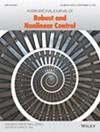Research on anti‐saturation horizontal vibration model and neural network adaptive integral terminal sliding mode control strategy for high‐speed elevator car system
IF 3.2
3区 计算机科学
Q2 AUTOMATION & CONTROL SYSTEMS
引用次数: 0
Abstract
A neural network adaptive integral terminal sliding mode control method with input saturation is proposed for the horizontal vibration problem of high‐speed elevator car systems caused by uncertainties such as guideway excitation and shaft piston wind change. First, considering the input saturation problem existing in the elevator control actuator, a class of smooth functions is introduced to approximate the nonlinearity of switching saturation, and an eight‐degree‐of‐freedom asymmetric anti‐saturation nonlinear system model of the high‐speed elevator car is established; second, in order to solve the singularity problem existing in the terminal sliding‐mode control, a nonlinear term is introduced into the sliding‐mode design, and a neural network is utilized for the fitting of the complex unknown function, and the design of the an adaptive integral terminal sliding mode controller (AITSMC), which enables the state variables of the system to achieve finite time convergence and proves the stability of the system by using Lyapunov theory; finally, under the action of two typical guide excitations, the proposed controller is compared with the passive control and adaptive control (AC), and the results show that, after adopting the proposed control method, the vibration acceleration eigenvalue is reduced by more than 60%, which effectively suppresses the horizontal vibration of the car system and verifies the effectiveness of the proposed controller.高速电梯轿厢系统抗饱和水平振动模型及神经网络自适应积分终端滑模控制策略研究
针对导轨激励和井道活塞风向变化等不确定因素引起的高速电梯轿厢系统水平振动问题,提出了一种具有输入饱和的神经网络自适应积分终端滑模控制方法。首先,考虑电梯控制执行器中存在的输入饱和问题,引入一类平滑函数来逼近开关饱和的非线性,并建立了高速电梯轿厢的八自由度非对称抗饱和非线性系统模型;其次,为解决末端滑模控制中存在的奇异性问题,在滑模设计中引入非线性项,利用神经网络对复杂未知函数进行拟合,设计了自适应积分末端滑模控制器(AITSMC),使系统状态变量实现有限时间收敛,并利用李雅普诺夫理论证明了系统的稳定性;最后,在两个典型的导向激励作用下,将所提出的控制器与被动控制和自适应控制(AC)进行了比较,结果表明,采用所提出的控制方法后,振动加速度特征值降低了 60% 以上,有效地抑制了汽车系统的水平振动,验证了所提出的控制器的有效性。
本文章由计算机程序翻译,如有差异,请以英文原文为准。
求助全文
约1分钟内获得全文
求助全文
来源期刊

International Journal of Robust and Nonlinear Control
工程技术-工程:电子与电气
CiteScore
6.70
自引率
20.50%
发文量
505
审稿时长
2.7 months
期刊介绍:
Papers that do not include an element of robust or nonlinear control and estimation theory will not be considered by the journal, and all papers will be expected to include significant novel content. The focus of the journal is on model based control design approaches rather than heuristic or rule based methods. Papers on neural networks will have to be of exceptional novelty to be considered for the journal.
 求助内容:
求助内容: 应助结果提醒方式:
应助结果提醒方式:


